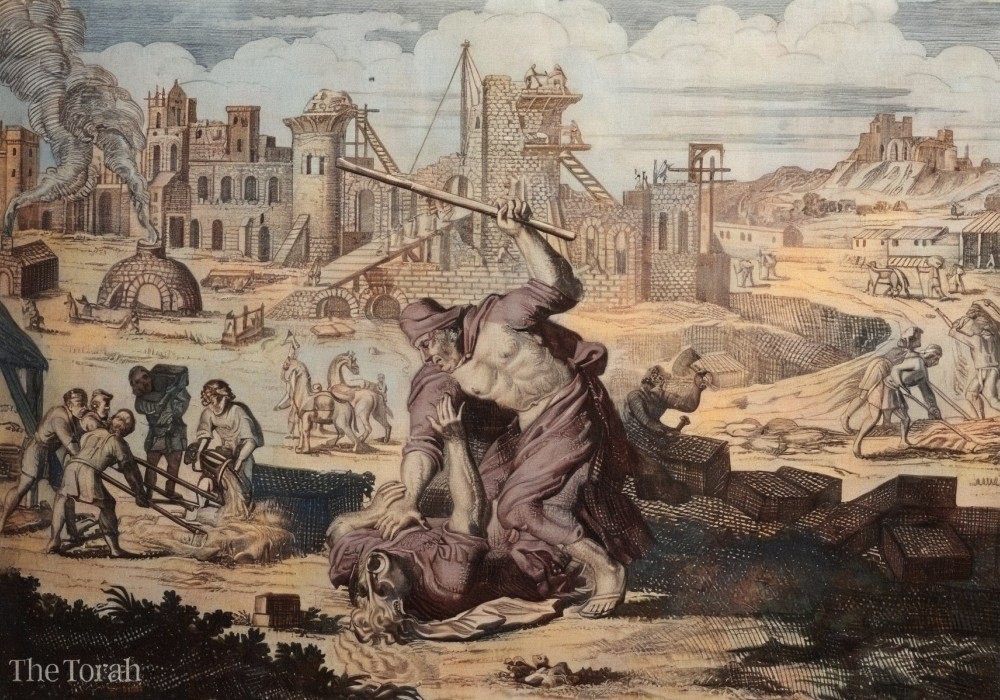The story of Moses’s discovery of his Hebrew heritage is a pivotal moment in the Exodus narrative. Raised as an Egyptian prince, his journey toward leading the Israelites out of slavery began with a profound act of empathy and a gradual awakening to his true identity. This article delves into the biblical text to explore how Moses came to understand his Hebrew roots.
Moses’s Encounter with Injustice
The book of Exodus describes Moses witnessing an Egyptian overseer beating a Hebrew slave.
 Moses striking the Egyptian, Amsterdam Haggadah, 1695-1712. Stanford University Libraries (colorized)
Moses striking the Egyptian, Amsterdam Haggadah, 1695-1712. Stanford University Libraries (colorized)
“After some time, Moses grew and went out to his brothers, and looked upon their burdens. He saw an Egyptian man strike a Hebrew man of his brothers.” (Exodus 2:11)
This verse raises a crucial question: did Moses intervene because he already knew he was Hebrew, or was it a spontaneous act of justice? The Hebrew word “brothers” (achim) appears twice in this verse, first referring to an ambiguous group and then specifically to the Hebrews. This subtle distinction suggests a shift in Moses’s understanding.
The Meaning of “Brothers”
Initially, “brothers” likely referred to Moses’s Egyptian peers. Growing up in Pharaoh’s palace, he would have identified with the Egyptians. However, witnessing the brutal treatment of the Hebrew slave, Moses’s perception of kinship changes. The text implies that he saw the injustice not as an outsider but as a wrong against “his brothers,” now clearly identifying with the oppressed Hebrews.
The Significance of “Burdens”
Further examination of Exodus 1:11, where the Egyptians impose “their burdens” on the Israelites to build garrison cities, sheds light on Moses’s evolving understanding. The Hebrew word for burdens (sibalot) can refer to both physical labor and the emotional weight of oppression. When Moses “looked upon their burdens” in Exodus 2:11, it might initially have referred to the Egyptians’ burden of overseeing the construction. However, witnessing the suffering of the Hebrew slaves transformed his understanding of “burdens” to encompass the Hebrews’ plight.
An Act of Justice, Not Kinship
Moses’s intervention wasn’t driven by familial obligation but by a deep sense of justice. This is reinforced by his later defense of the Midianite women against their own countrymen (Exodus 2:16-17). This act demonstrates Moses’s inherent compassion and willingness to fight for the vulnerable, regardless of their ethnicity. These actions reveal a man guided by moral principles, not blood ties.
Betrayal and the Solidification of Identity
The day after killing the Egyptian, Moses tried to mediate a fight between two Hebrews, only to be met with a hostile accusation: “Who made you a prince and a judge over us? Do you intend to kill me as you killed the Egyptian?” (Exodus 2:14). This betrayal solidified Moses’s break from his Egyptian past and deepened his identification with the Hebrews. Rejected by those he defended, Moses understood that his destiny lay with the oppressed.
Conclusion
Moses’s realization of his Hebrew identity was a process, not an instantaneous revelation. It was triggered by witnessing injustice, deepened by a shift in his understanding of kinship and burden, and solidified by the betrayal of the Hebrews he defended. His transformation from Egyptian prince to Hebrew leader demonstrates the power of empathy and the enduring human capacity for moral growth. His journey highlights that true belonging often stems not from birthright but from shared experiences and a commitment to justice.